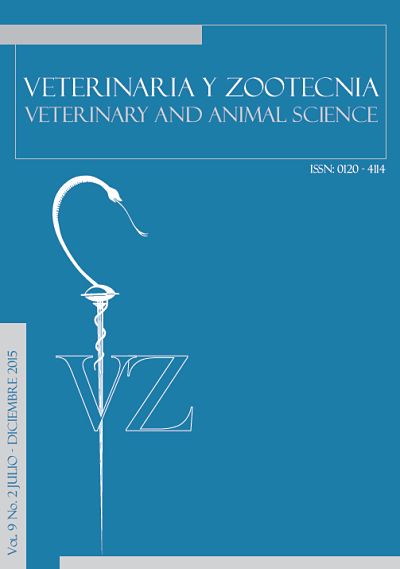Authors
Abstract
The agents that cause diseases of zoonotic importance in canines, such as Canine brucellosis and Leptospirosis, have gained importance in human clinical practice. Objective: To discover the prevalence and behavior of both diseases in the canine population in the city of Medellín to develop measures of prevention and control in this area. Methods: A total of 1,300 canines were sampled to test for Brucella canis and Leptospira spp. using the PARP-2ME and MAT techniques, respectively, to establish the statistical significance of the different variables analyzed (P ≤ 0.05; OR ≥ 1; 95% CI). Results: Seroprevalence was determined to be 7.32% for B. canis and 9.08%, for Leptospira spp. with a 0.77% co-infection rate of both diseases. The most prevalent serovars for Leptospira spp. were Canicola (3.38%), Icterohaemorrhagiae (2.62%), and Pomona (0.92%). A statistical association was reported for B. canis with the commune variable (San Javier P = 0.002; OR = 2.724 / Guayabal P = 0.000; OR = 3.862 / Belén P = 0.002; OR = 2.953), and for Leptospira spp. with the commune variable (Buenos Aires P = 0.011; OR = 2.220) and age (37-48 months P = 0.005; OR = 4.272). Conclusions: This study shows that both agents are in circulation among the canine population in the city and in all the communes analyzed, representing a possible risk of infection to owners and other animals entering into contact with them.
Keywords
References
Álvarez, L.; Calderón, A.; Rodríguez, V. et al. Seroprevalencia de leptospirosis canina en una comunidad rural del municipio de Ciénaga de Oro, Córdoba (Colombia). Revista U.D.C.A Actualidad & Divulgación Científica,v.14, n.2, p.75-81, 2011.
Ardoino, S.M.; Baruta, D.A.; Toso, R.E. Brucelosis canina. Ciencia veterinaria,v.8, n.1, p.50-61, 2017.
Carreño, L.A.; Salas, D.; Beltrán, K.B. Prevalencia de leptospirosis en Colombia: revisión sistemática de literatura. Revista de Salud Pública,v.19, n.2, p.204-209, 2017.
Castrillón, L.; Giraldo, C.A.; Sánchez, M.M. et al. Factores asociados con la seropositividad a Brucella canis en criaderos caninos de dos regiones de Antioquia, Colombia. Cadernos de Saúde Pública,v.29, n.10, p.1975-1987, 2013.
Castrillón, L.; López, L.; Sancheze, R. et al. Prevalence of presentation of some zoonotic agents transmitted by canines and felines in Medellín, Colombia. Revista Mvz Cordoba,v.24, n.1, p.7119-7126, 2019.
Delaude, A.; Rodriguez, S.; Dreyfus, A. et al. Canine leptospirosis in Switzerland—a prospective cross-sectional study examining seroprevalence, risk factors and urinary shedding of pathogenic leptospires. Preventive veterinary medicine,v.141, p.48-60, 2017.
Echeverri, L.M.; Penagos, S.; Castañeda, L. et al. Características sociodemográficas y clínicas de pacientes con infección por Leptospira spp. atendidos en cuatro centros hospitalarios de Medellín, Colombia, 2008-2013. Biomédica,v.37, n.1, p.62-67, 2017.
Flores, B.J.; Pérezz, T.; Fuertes, H. et al. A cross-sectional epidemiological study of domestic animals related to human leptospirosis cases in Nicaragua. Acta tropica,v.170, p.79- 84, 2017.
Giraldo, C.A.; Ruiz, Z.T.; Olivera, M. Brucella canis en Medellín (Colombia), un problema actual. Revista U.D.C.A Actualidad & Divulgación Científica,v.12, n.1, p.51-57, 2009.
Langoni, H.; Ponte, M.C.d.; Barbosa, D. et al. PESQUISA DE ANTICORPOS E DE DNA DE Leptospira spp. EM SORO CANINO. Veterinária e Zootecnia,v.22, n.3, p.429- 436, 2015.
Lucero, N.E.; Maldonado, P.L.; Kaufman, S. et al. Brucella canis causing infection in an HIV-infected patient. Vector-Borne and Zoonotic Diseases,v.10, n.5, p.527-529, 2010.
Manias, V.; Nagel, A.; Mollerach, A. et al. Endocarditis por Brucella canis: primer caso documentado en un paciente adulto en Argentina. Revista argentina de microbiología,v.45, n.1, p.50-53, 2013.
Meeyam, T.; Tablerk, P.; Petchanok, B. et al. Seroprevalence and risk factors associated with leptospirosis in dogs. Southeast Asian journal of tropical medicine and public health,v.37, n.1, p.148, 2006.
Miotto, B.A.; Guilloux, A.G.A.; Tozzi, B.F. et al. Prospective study of canine leptospirosis in shelter and stray dog populations: Identification of chronic carriers and different Leptospira species infecting dogs. PloS one,v.13, n.7, 2018.
Olivera, M.; Di-Lorenzo, C. Aislamiento de Brucella canis en un humano conviviente con caninos infectados. Informe de un caso. Colombia Médica,v.40, n.2, p.218-220, 2009.
Olivera, M.; Giraldo, C.; Di-Lorenzo, C. Identificación por PCR de Brucella canis en sangre y leche canina: Reporte de un caso. Archivos de medicina veterinaria,v.43, n.3, p.295-298, 2011.
Pulido, A.; Carreño, G.; Mercado, M. et al. Situación epidemiológica de la leptospirosis humana en Centroamérica, Suramérica y el Caribe. Universitas Scientiarum,v.19, n.3, p.247-264, 2014.
Ruíz, J.D.; Giraldo, C.A.; López, L.V. et al. Brucella canis seroprevalence in stray dogs from" Centro de Bienestar Animal" La Perla", Medellín (Colombia), 2008. Revista Colombiana de Ciencias Pecuarias,v.23, n.2, p.166-172, 2010.
Salas. INFORME DE EVENTO LEPTOSPIROSIS, COLOMBIA, 2017. Equipo Funcional Enfermedades Trasmitidas por Vectores. Colombia: INS y MiniSalud, 2018.
Sánchez, M.; Giraldo, C.A.; Olivera, M. Infección por Brucella canis en humanos: propuesta de un modelo teórico de infección a través de la ruta oral. Infectio,v.17, n.4, p.193-200, 2013.
Sánchez, M.; Ortiz, L.F.; Castrillón, L.L. et al. Application of a polymerase chain reaction test for the detection of Brucella canis from clinical samples of canines and humans. Revista Colombiana de Ciencias Pecuarias,v.27, n.1, p.3-11, 2014.
Souza, T.D.; Carvalho, T.F.; Silva, J.P. et al. Tissue distribution and cell tropism of Brucella canis in naturally infected canine foetuses and neonates. Scientific reports,v.8, n.1, p.1-10, 2018.
Ward, M.P.; Guptill, L.F.; Wu, C.C. Evaluation of environmental risk factors for leptospirosis in dogs: 36 cases (1997–2002). Journal of the American Veterinary Medical Association,v.225, n.1, p.72-77, 2004.

 pdf (Español (España))
pdf (Español (España))
 FLIP
FLIP















